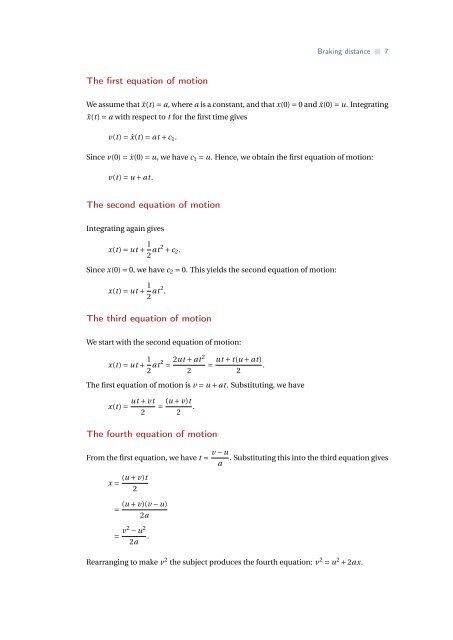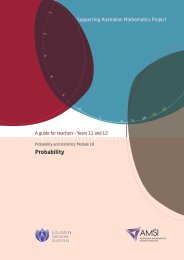Braking distance - the Australian Mathematical Sciences Institute
Braking distance - the Australian Mathematical Sciences Institute
Braking distance - the Australian Mathematical Sciences Institute
- No tags were found...
Create successful ePaper yourself
Turn your PDF publications into a flip-book with our unique Google optimized e-Paper software.
<strong>Braking</strong> <strong>distance</strong> ■ 7The first equation of motionWe assume that ẍ(t) = a, where a is a constant, and that x(0) = 0 and ẋ(0) = u. Integratingẍ(t) = a with respect to t for <strong>the</strong> first time givesv(t) = ẋ(t) = at + c 1 .Since v(0) = ẋ(0) = u, we have c 1 = u. Hence, we obtain <strong>the</strong> first equation of motion:v(t) = u + at.The second equation of motionIntegrating again givesx(t) = ut + 1 2 at 2 + c 2 .Since x(0) = 0, we have c 2 = 0. This yields <strong>the</strong> second equation of motion:x(t) = ut + 1 2 at 2 .The third equation of motionWe start with <strong>the</strong> second equation of motion:x(t) = ut + 1 2 at 2 22ut + at ut + t(u + at)= = .22The first equation of motion is v = u + at. Substituting, we haveut + vtx(t) =2(u + v)t= .2The fourth equation of motionFrom <strong>the</strong> first equation, we have t = v − u . Substituting this into <strong>the</strong> third equation givesa(u + v)tx =2(u + v)(v − u)=2a= v 2 − u 2.2aRearranging to make v 2 <strong>the</strong> subject produces <strong>the</strong> fourth equation: v 2 = u 2 + 2ax.
















